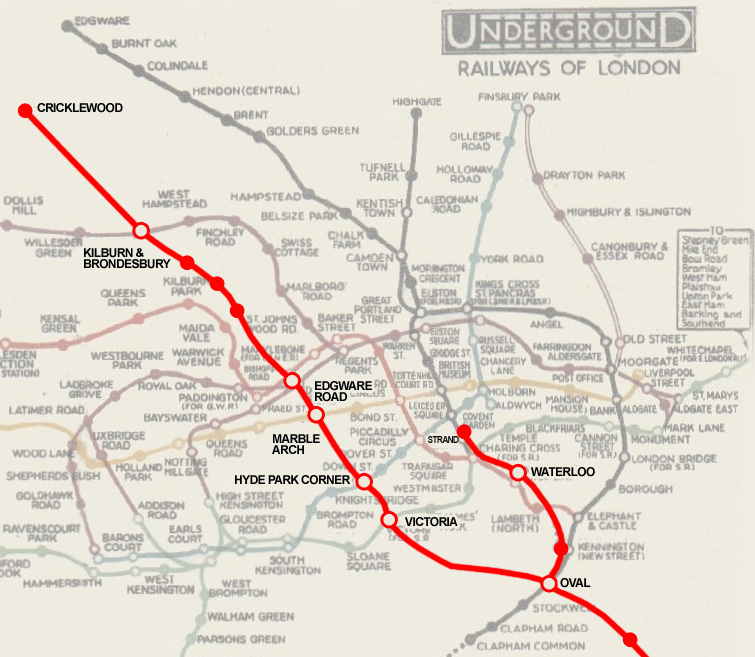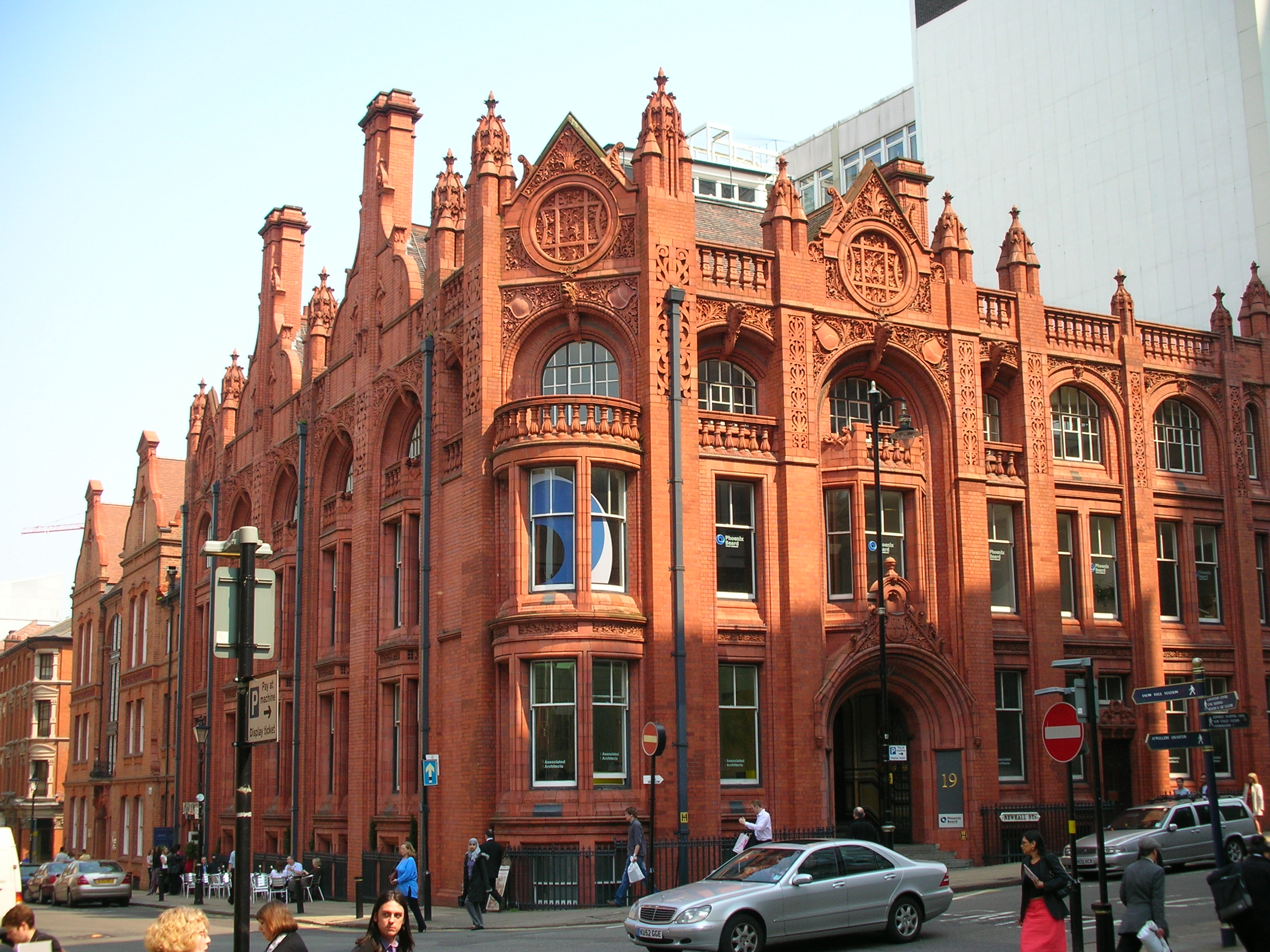|
Edgware Road Tube Station (Bakerloo Line)
Edgware Road () is a London Underground station. It is on the Bakerloo line between Paddington and Marylebone stations, and is in Travelcard zone 1. The station is located on the north-east corner of the junction of Edgware Road, Harrow Road and Marylebone Road. It is adjacent to the Marylebone flyover. A separate station of the same name but served by the Circle, District and Hammersmith & City lines is nearby, to the south of Marylebone Road.The other station was opened by the Metropolitan Railway in 1863 as part of the world's first underground railway. There have been proposals in the past to rename one of the Edgware Road stations to avoid confusion. Neither of them should be confused with Edgware station, the northern terminus of the Edgware branch of the Northern line. History Edgware Road station was opened on 15 June 1907 by the Baker Street and Waterloo Railway (BS&WR, now the Bakerloo line) when it extended its line from the temporary northern terminus at Mary ... [...More Info...] [...Related Items...] OR: [Wikipedia] [Google] [Baidu] |
London Underground
The London Underground (also known simply as the Underground or as the Tube) is a rapid transit system serving Greater London and some parts of the adjacent home counties of Buckinghamshire, Essex and Hertfordshire in England. The Underground has its origins in the Metropolitan Railway, opening on 10 January 1863 as the world's first underground passenger railway. The Metropolitan is now part of the Circle line (London Underground), Circle, District line, District, Hammersmith & City line, Hammersmith & City and Metropolitan lines. The first line to operate underground electric locomotive, electric traction trains, the City & South London Railway in 1890, is now part of the Northern line. The network has expanded to 11 lines with of track. However, the Underground does not cover most southern parts of Greater London; there are only 33 Underground stations south of the River Thames. The system's List of London Underground stations, 272 stations collectively accommodate up ... [...More Info...] [...Related Items...] OR: [Wikipedia] [Google] [Baidu] |
Baker Street And Waterloo Railway
The Baker Street and Waterloo Railway (BS&WR), also known as the ''Bakerloo tube'', was a railway company established in 1893 that built a deep-level underground "tube" railway in London. The company struggled to fund the work, and construction did not begin until 1898. In 1900, work was hit by the financial collapse of its parent company, the London & Globe Finance Corporation, through the fraud of Whitaker Wright, its main shareholder. In 1902, the BS&WR became a subsidiary of the Underground Electric Railways Company of London (UERL) controlled by American financier Charles Yerkes. The UERL quickly raised the funds, mainly from foreign investors. When first opened in 1906, the BS&WR's line served nine stations and ran completely underground in a pair of tunnels for between its northern terminus at Baker Street and its southern terminus at Elephant and Castle with a depot on a short spur nearby at London Road. Extensions between 1907 and 1913 took the northern end of the lin ... [...More Info...] [...Related Items...] OR: [Wikipedia] [Google] [Baidu] |
London Transport Executive (GLC)
The London Transport Executive was the executive agency within the Greater London Council, responsible for public transport in Greater London from 1970 to 1984. In common with all London transport authorities from 1933 to 2000, the public name and operational brand of the organisation was London Transport (brand), London Transport. Background and formation The Greater London Council came into its powers in 1965, but did not have authority over public transport. Responsibility for such provision had been removed from the London County Council and neighbouring authorities in 1933 and passed to the London Passenger Transport Board. The Transport (London) Act 1969 gave the GLC powers over the London Underground and London Buses, but not over British Rail services in Greater London. Fares policy The GLC aimed to increase usage of public transport, especially in Outer London, where car use was high. Fare setting policy was used to increase patronage on the London Underground and Lon ... [...More Info...] [...Related Items...] OR: [Wikipedia] [Google] [Baidu] |
Overpass
An overpass, called an overbridge or flyover (for a road only) in the United Kingdom and some other Commonwealth countries, is a bridge, road, railway or similar structure that is over another road or railway. An ''overpass'' and '' underpass'' together form a grade separation. Stack interchanges are made up of several overpasses. History The world's first railroad flyover was constructed in 1843 by the London and Croydon Railway at Norwood Junction railway station to carry its atmospheric railway vehicles over the Brighton Main Line. Highway and road In North American usage, a ''flyover'' is a high-level overpass, built above main overpass lanes, or a bridge built over what had been an at-grade intersection. Traffic engineers usually refer to the latter as a '' grade separation''. A flyover may also be an extra ramp added to an existing interchange, either replacing an existing cloverleaf loop (or being built in place of one) with a higher, faster ramp that eventua ... [...More Info...] [...Related Items...] OR: [Wikipedia] [Google] [Baidu] |
The Times
''The Times'' is a British Newspaper#Daily, daily Newspaper#National, national newspaper based in London. It began in 1785 under the title ''The Daily Universal Register'', adopting its modern name on 1 January 1788. ''The Times'' and its sister paper ''The Sunday Times'' (founded in 1821), are published by Times Media, since 1981 a subsidiary of News UK, in turn wholly owned by News Corp. ''The Times'' and ''The Sunday Times'' were founded independently and have had common ownership only since 1966. It is considered a newspaper of record in the UK. ''The Times'' was the first newspaper to bear that name, inspiring numerous other papers around the world. In countries where these other titles are popular, the newspaper is often referred to as or , although the newspaper is of national scope and distribution. ''The Times'' had an average daily circulation of 365,880 in March 2020; in the same period, ''The Sunday Times'' had an average weekly circulation of 647,622. The two ... [...More Info...] [...Related Items...] OR: [Wikipedia] [Google] [Baidu] |
Victoria (NWLR) Tube Station
There were a number of proposals to build an underground railway along the Edgware Road in north-west London, England, at the end of the 19th century. Each scheme envisaged building some form of rail tunnel under Edgware Road towards Victoria railway station. These proposals were made at a time of intensive railway construction, following projects such as City and South London Railway. Like several other proposals at the time, such as the City and Brixton Railway, none of the Edgware Road schemes came to fruition. Edgware Road and Victoria Railway The Edgware Road and Victoria Railway (ER&VR) was an early scheme for an underground railway under the Edgware Road. The promoters sought to raise capital of £1.2 million (£ today) to cover the estimated railway construction costs of £920,000 and the cost of constructing a dedicated power station for the railway at the Paddington Basin. The ER&VR was planned to run on a north-west-to-south-east axis, more or less following the ... [...More Info...] [...Related Items...] OR: [Wikipedia] [Google] [Baidu] |
Sussex Gardens
Sussex Gardens is a street in Paddington in Central London. It runs westwards from the Edgware Road, for most of the way as a broad Avenue (landscape), avenue until it reaches an area near Lancaster Gate where it becomes a garden square. Part of the City of Westminster, it is located in the residential area of Tyburnia north of Hyde Park, London, Hyde Park. Streets running off it include Westbourne Terrace, Talbot Square, London Street and Southwick Street. Sussex Gardens provides the main axis for the area. The street was originally known as Grand Junction Street, named after the nearby Grand Junction Waterworks Company, Grand Junction Waterworks. It was laid out as part of the ambitious street plan for Tyburnia in 1809, designed by the architect Samuel Pepys Cockerell. Delays, partly caused by the Panic of 1825, meant that the street was not fully completed until the early Victorian Era to a revised plan by George Gutch. The first houses were available for lease in 1826 at th ... [...More Info...] [...Related Items...] OR: [Wikipedia] [Google] [Baidu] |
Architectural Terracotta
Architectural terracotta refers to a fired mixture of clay and water that can be used in a non-structural, semi-structural, or structural capacity on the exterior or interior of a building. Terracotta is an ancient building material that translates from Latin as "wikt:terracotta, baked earth". Some architectural terracotta is stronger than stoneware. It can be unglazed, painted, slip glazed, or Glazed architectural terra-cotta, glazed. Usually solid in earlier uses, in most cases from the 19th century onwards each piece of terracotta is composed of a hollow clay web enclosing a void space or cell. The cell can be installed in compression with Mortar (masonry), mortar or hung with metal anchors; such cells are often partially backfilled with mortar. Terracotta can be used together with brick, for ornamental areas; if the source of the clay is the same they can be made to harmonize, or if different to contrast. It is often a cladding over a different structural material. Hist ... [...More Info...] [...Related Items...] OR: [Wikipedia] [Google] [Baidu] |




